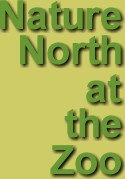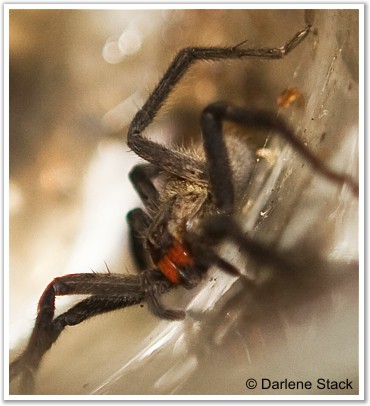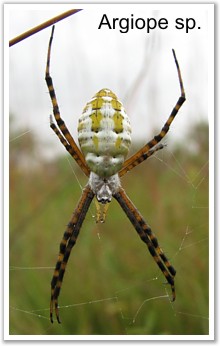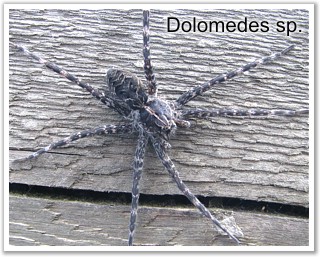
Return to:
NatureNorth's
front page
NatureNorth
at the Zoo
|
|

 Tale of a Wandering Spider Tale of a Wandering Spider
By Dr. Robert E. Wrigley, Curator, Assiniboine Park Zoo (Please see Update)
In early May, 2009 a story was released by the Russell Banner’s Terrie Welwood about a highly venomous spider -- the Brazilian Wandering Spider -- from tropical America, which arrived in a box of bananas at an IGA grocery store in Russell, Manitoba. Through the efforts of a number of people, the 2.5-cm-long spider with long legs and red hairy fangs made its way to the Assiniboine Park Zoo. Considering that the fear of spiders (arachnophobia) is almost universal, it is remarkable that a chain of individuals cared enough about this little wandering stowaway to ensure that no harm came to it after surviving its over-4000-km trip from the tropics.
The spider appears to have started its journey by hiding in a load of bananas in Guatemala, and then being transported to Manitoba. The box of bananas was ultimately shipped to the IGA in Russell, where one night it left its refuge to search for prey. A cleaning-staff member (Collaus Summer) discovered the spider and succeeded in trapping it in a container. He handed it over to the Produce Manager (Bev Doubleday), who then in turn gave it to the Major Pratt High School 12th-grade biology class for study. Using the resources of the internet, the students took up the challenge of identifying it, and they came to the startling conclusion (based on its size and striking red fangs) that it was a venomous Brazilian Wandering Spider (a species of Phoneutria; Greek name for “Murderess”), the bites of several species of which have resulted in the deaths of small children and seniors in Amazonia. Although the bites of these spiders are highly sensationalized as the most-venomous and painful in the world, venom is often not released, or is delivered in such small doses that it is insufficient to kill most human victims.
Amid stories in the media, the spider was passed on by one of the students (Cameron Davidson) to two Manitoba Conservation staff (Grant White and Barry Verbewski), and with the recommendation from a Canadian Wildlife Service officer (Richard Laboissiere), they delivered the spider on May 8 to the Assiniboine Park Zoo for safe-keeping. It was set up securely in a terrarium for public viewing in the Tropical House by zookeepers (Val Norquay and Gary Ruczak) experienced in maintaining spiders. Until its identification could be confirmed, it was treated as a potentially dangerous specimen. When offered a cricket as food, the spider instantly captured and then devoured the insect, so the spider appeared to be in good health after its long journey.
 Zoo Curator Dr. Robert Wrigley contacted Dr. Terry Galloway at the Entomology Department at the University of Manitoba, who recommended he speak to Canadian spider specialist Dr. Robb Bennett with the British Columbia provincial government. Dr. Bennett acknowledged that spiders are easily misidentified, and while this specimen might be a Phoneutria, it was far-more likely to be a harmless species of wandering spider called Cupiennius, a species that also has the red hairs on the large fangs. These spiders have been known to be transported in fruit to other North American cities (e.g., Tulsa in March, 2008), where they are usually misidentified by local spider experts as the venomous Phoneutria. Other large stowaway spiders (e.g., wandering and black-widows) have been turned over to the Zoo and the J.B. Wallis Museum of Entomology (University of Manitoba) over the years, mainly deriving from shipments of produce. This Manitoba specimen will be submitted to a professor at the University of California at Berkeley, who is preparing a paper on accidental shipments of exotic creatures. The huge volume of cargo being transported around the world generates frequent opportunities for invasive pests to reach new continents, where they often cause enormous damage to native ecosystems and national economies (e.g., agriculture, forestry). Zoo Curator Dr. Robert Wrigley contacted Dr. Terry Galloway at the Entomology Department at the University of Manitoba, who recommended he speak to Canadian spider specialist Dr. Robb Bennett with the British Columbia provincial government. Dr. Bennett acknowledged that spiders are easily misidentified, and while this specimen might be a Phoneutria, it was far-more likely to be a harmless species of wandering spider called Cupiennius, a species that also has the red hairs on the large fangs. These spiders have been known to be transported in fruit to other North American cities (e.g., Tulsa in March, 2008), where they are usually misidentified by local spider experts as the venomous Phoneutria. Other large stowaway spiders (e.g., wandering and black-widows) have been turned over to the Zoo and the J.B. Wallis Museum of Entomology (University of Manitoba) over the years, mainly deriving from shipments of produce. This Manitoba specimen will be submitted to a professor at the University of California at Berkeley, who is preparing a paper on accidental shipments of exotic creatures. The huge volume of cargo being transported around the world generates frequent opportunities for invasive pests to reach new continents, where they often cause enormous damage to native ecosystems and national economies (e.g., agriculture, forestry).
Manitoba is host to about 700 species of spiders, which occupy almost all terrestrial habitats and some aquatic ones as well. They play major roles as predators of insects and other small organisms, and serve as food for songbirds and many other kinds of animals. All Manitoba spiders carry venom to immobilize and digest prey, but none is dangerous to humans, although the bite of a few species can be painful and cause a local irritation or mild allergic reaction. The public is encouraged to leave spiders alone to carry out their natural lives, and to not destroy them out of needless fear.
[The garden spider (Argiope sp.) and the dock spider (Dolomedes sp.) are both common Manitoba spiders.]
 In the autumn, many people are alarmed to discover an impressively large spider (with two bumps on the abdomen) in a web around the home, resulting in a call to the Zoo, a university, Manitoba Museum, or Insect Control (City Of Winnipeg). This is usually the Jewel Spider (Aranaeus gemmoides), the females of which have a respectable head-body length of up to 15 mm. One of western Canada’s largest orb-weaver spiders, it is docile and only bites if repeatedly provoked. David Wade from Insect Control noted that by September, the female has mated with the smaller male, and is looking for a secluded site to deposit her egg case, which may contain 800 fertilized eggs. It appears that houses are a preferred site for stashing the egg case. The female dies and the cold-hardy eggs over-winter, then hatch with the warming days of spring. On a sunny day, each tiny spiderling releases a strand of silk and parachutes away on the wind, to renew the species’ cycle of life. In the autumn, many people are alarmed to discover an impressively large spider (with two bumps on the abdomen) in a web around the home, resulting in a call to the Zoo, a university, Manitoba Museum, or Insect Control (City Of Winnipeg). This is usually the Jewel Spider (Aranaeus gemmoides), the females of which have a respectable head-body length of up to 15 mm. One of western Canada’s largest orb-weaver spiders, it is docile and only bites if repeatedly provoked. David Wade from Insect Control noted that by September, the female has mated with the smaller male, and is looking for a secluded site to deposit her egg case, which may contain 800 fertilized eggs. It appears that houses are a preferred site for stashing the egg case. The female dies and the cold-hardy eggs over-winter, then hatch with the warming days of spring. On a sunny day, each tiny spiderling releases a strand of silk and parachutes away on the wind, to renew the species’ cycle of life.
Photo Credits
Photos in this article are by NatureNorth and Darlene Stack.
|